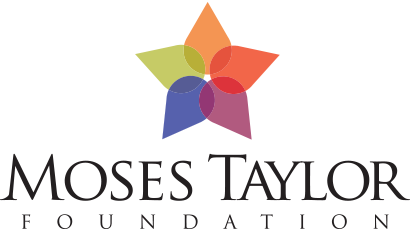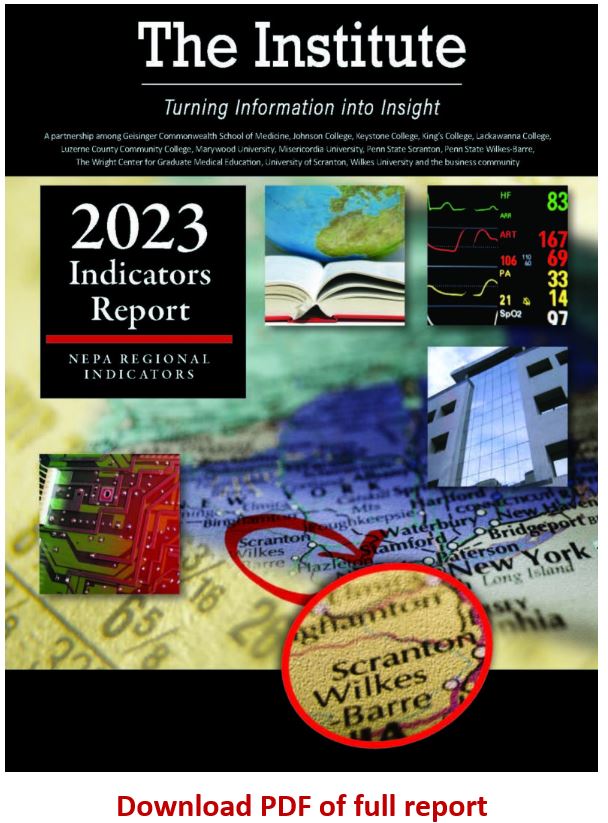Thank You
Thank you to the following organizations for their continued support of our research and this Data Dashboard, which is part of Project STIR (Sparking Transformation using Information & Research).
Homes by year built
As of 2021, Lackawanna, Luzerne, and Wayne Counties were slightly behind the Commonwealth in terms of recent building. Lackawanna and Luzerne Counties also had smaller shares of homes built between 2000 and 2009, indicating that the nationwide housing construction boom of the early 2000s was less apparent in this region. However, Wayne County had a much higher share of its housing built in the 1980s, 1990s, and early 2000s.
Compared to Pennsylvania, much higher percentages of housing stock in Lackawanna and Luzerne Counties were built prior to 1940 – 37.5 percent in Lackawanna County and 33 percent in Luzerne County compared to 26 percent statewide. However, a smaller share of Wayne County’s housing is older than 1940, at 18 percent.
Homes by Year Built – 2021
Source: U.S. Census Bureau, 2021 American Community Survey 5-Year Estimates
Building Permits and Construction Costs
The number of building permits issued in Luzerne County has largely matched or exceeded levels seen before the last recession. Despite the pandemic, building permits issued in Luzerne County were higher in number during 2020 and 2021 than they were in 2017, 2018, or 2019. In the most recent year, 365 units were permitted among 344 buildings.
In Lackawanna County, 186 buildings comprising 254 housing units were permitted. The total number of units in 2021 was the highest since 2017, but remains well below levels of building activity seen before the last recession (2007 through 2009) and during the period from 2014 to 2016.
In Wayne County, the units and buildings permitted both totaled 133 (indicating that all units were single family structures). This amount represents the highest number of units permitted since 2010, which marked the end of several years of rapid building.
Construction costs have generally correlated with permitting activity in each county.
Units Permitted
Source: U.S. Census Bureau Building Permits Survey
Occupancy/Vacancy
From 2017 to 2021, 87 percent of all housing units in Lackawanna County were occupied – unchanged from the prior five-year period but slightly lower than the 2007-2011 period. The percentage in Luzerne County rose from 86 percent in 2012-2016 to 87 percent most recently. Wayne County’s occupancy rate has typically stood around 60 percent; the higher vacancy rate is not necessarily indicative of widespread blight but influenced by factors such as presence of vacation rentals and seasonally occupied properties. The Commonwealth’s occupancy rate increased slightly to 90 percent, just over one percentage point higher than five years prior.
Occupancy/Vacancy
Source: U.S. Census Bureau, American Community Survey 5 year Estimates
Housing Tenure
Housing tenure refers to the breakdown of those who own their homes versus those who rent. Lackawanna and Luzerne Counties have seen a gradual shift away from homeownership, with the shares of renters growing from 31 percent to 32 percent in Luzerne County and from 33 percent to 35 percent in Lackawanna County over each period analyzed. Wayne County has not seen a clear trend but has had much higher shares of homeowners overall. Statewide, the share of renters is just under 31 percent, a minimal decline from the prior five-year period but larger than it was a decade ago.
Lackawanna: 2017-2021 Owner to Renter Comparison
Source: U.S. Census Bureau, American Community Survey 5 year Estimates
Luzerne: 2017-2021 Owner to Renter Comparison
Source: U.S. Census Bureau, American Community Survey 5 year Estimates
Wayne: 2017-2021 Owner to Renter Comparison
Source: U.S. Census Bureau, American Community Survey 5 year Estimates
Pennsylvania: 2017-2021 Owner to Renter Comparison
Source: U.S. Census Bureau, American Community Survey 5 year Estimates
Housing / Rental Affordability
For owner-occupied housing, affordability is measured by monthly cost of ownership. Selected Monthly Owner Costs (SMOC), as defined by the U.S. Census Bureau, include mortgage payment, real estate taxes, various insurances, utilities, fuels, mobile home costs, and condominium fees. Only owner-occupied units with mortgages are included in this dataset.
From 2017 to 2021, Lackawanna and Luzerne Counties’ median SMOC were mostly between 20 percent and 23 percent of the median household income for homeowners. In Wayne County, the ratio was typically 26 percent to 27 percent, higher than the other two counties and the state as a whole. Ratios have been lower over the last several years than the comparison year of 2010 for all three counties and statewide, indicating that on average, homeowners have become somewhat less burdened by housing costs over time. Because this statistic is a ratio of homeownership costs to median income, there is no need to adjust for inflation.
A similar calculation was used for rental housing. The median rent as a percentage of median renter household income for all four geographies has fluctuated, usually staying within a few percentage points of 30 percent in recent years.
The ratio of median rent to median income increased to 31.5 percent in Lackawanna County and decreased to 26.5 percent in Luzerne County in 2021. In Wayne County, the ratio decreased to 30 percent. The statewide ratio rose marginally to 30.5 percent. A household is considered cost-burdened when housing-related spending exceeds 30 percent of its income, meaning that it may struggle to afford other necessities.
In each geography, the ratio of income to housing costs for renters was consistently less favorable than the ratio for homeowners.
% of Income for Owner Costs
Source: U.S. Census Bureau, American Community Survey 1-Year Estimates (Lackawanna, Luzerne, PA), 5-Year Estimates (Wayne)
% of Income for Rent
Source: U.S. Census Bureau, American Community Survey 1-Year Estimates (Lackawanna, Luzerne, PA), 5-Year Estimates (Wayne)
Housing Value Comparison
In this year’s report, statistics on housing values were obtained from data collected by Zillow. The Zillow Home Value Index is a measure of typical home values in a region for mid-range homes (in the 35th- 65th price percentile). Home prices nationwide rose by 36 percent from 2000 to 2010 and by 46 percent from 2010 to 2019. Regionally and statewide, home prices rose more gradually from 2010 to 2019 – from 13 percent to 20 percent during that time.
The pandemic, however, brought a much more rapid increase in home prices. Since 2019, the typical home price has risen 37 percent in Lackawanna County, 42 percent in Luzerne County, and 65 percent in Wayne County. All three counties’ saw home values grow at a faster pace than the state’s rate of 35 percent during that time.
Market prices have also increased for rental units. Within the Scranton/Wilkes-Barre/Hazleton metropolitan area, typical market rents for units in the 40th to 60th percentile reached $1,172 in 2022, up 11 percent from the prior year and 33 percent compared to 2019, when the typical rent in the metro area was $882. Nationwide, market rents increased by 25 percent from 2019 to 2022.
Housing Value Comparison
Source: Zillow Research ZHVI (Zillow Home Value Index). Each value is the average of all available monthly data. Prior data has been revised.
Housing Density Comparison
Housing density data for each county and Pennsylvania showed small increases in homes per square mile between 2000, 2010, and 2021, in accordance with small increases in the estimated number of housing units. In Lackawanna County, Luzerne County, and Pennsylvania, the number of homes per square mile in 2019 were 214.8, 166.1, and 126.4 respectively, indicating that the two counties have higher housing densities than the Commonwealth as a whole. Wayne County’s density of 42.5 homes per square mile was only about one-third of the housing density of the Commonwealth.
Homes per square mile
Source U.S. Census Bureau, American Community Survey
Mortgage Activity Comparison
Generally, between 54 percent and 57 percent of owner-occupied homes in Lackawanna County had mortgages since 2007. Luzerne County saw an increase from 2000 to the 2007-2011 period, but more recent estimates showed a decreasing trend. Wayne County has also seen declines, where the share of owner-occupied homes with mortgages has fallen below 50 percent.
Median monthly owner costs, which include mortgage payments as well as real estate taxes, various insurances, utilities, fuels, mobile home costs, and condominium fees, increased in each geography. The median monthly owner costs in all three counties have remained lower than those at the state level.
% with Mortgage
Source: U.S. Census Bureau, American Community Survey
Market Conditions
Data on for-sale inventory, the number of homes available for sale, was available for the Scranton/Wilkes-Barre/Hazleton metropolitan area, which includes Lackawanna, Luzerne, and Wyoming Counties.
For-sale inventory dropped steadily between the first quarter of 2020 and the first quarter of 2021, indicating tight housing market conditions – a seller’s market. For-sale inventory trended upward in late 2021, but fell again in early 2022, and remains below pre-pandemic levels as of the fourth quarter of 2022. Nationwide, a similar trend was observed.
For Sale Inventory: Recent Trends
Monthly average for each quarter
Source: Zillow Research
Foreclosures
The numbers of foreclosures in the region and statewide were generally highest in 2012 and 2013, representing a peak associated with the last recession. In Lackawanna and Wayne Counties, foreclosures have continued to trend downward. Luzerne County’s foreclosure total has been trending upward since 2016. However, the counties saw new lows in foreclosures in 2020 and 2021 as a result of the moratorium on foreclosures. The 2021 totals were 73 percent to 80 percent lower in each region compared to 2019, in accordance with the moratorium which covered about 70 percent of mortgages nationwide. The moratorium expired on July 31, 2021.
Foreclosures
Source: The Unified Judicial System of Pennsylvania
Homelessness
Homelessness data is tracked annually via point-in-time counts reported to the U.S. Department of Housing and Urban Development. In 2021, local agencies responsible for conducting the point-in-time counts were given the option of modifying count procedures due to the COVID-19 pandemic. Since then, some data has been limited – in particular, data on shelter status is incomplete and thus the total number of unhoused individuals does not include those unsheltered at the time of the count in cases where unsheltered data was not collected. Data is reported by Continuum of Care regions across Pennsylvania. These include Lackawanna County, Luzerne County, and the Eastern Pennsylvania Continuum of Care, which is composed of 33 primarily rural counties – including Wayne County.
Statewide, the number of sheltered homeless households fell in January 2021. This may be related to the eviction moratorium or other supports preventing some vulnerable households from becoming homeless. In 2022, the number in emergency shelter rose, though the number who were counted as unsheltered remained lower than levels seen from 2017 to 2020. The percent of homeless households that were sheltered in either transitional or emergency housing has typically ranged from about 90 percent to 95 percent in Lackawanna and Luzerne Counties, from 82 percent to 86 percent statewide, and from 73 percent to 84 percent in the Eastern PA CoC region.
The portion of homeless individuals who are under age 18 has been gradually falling statewide, and in most years, the region has seen a slightly higher share of children among the unhoused – averaging 27 percent compared to 24 percent statewide.
Homelessness
Source: US Department of Housing & Urban Development
Pennsylvania Homelessness
Source: US Department of Housing & Urban Development








 Sarah, a former Institute intern, joined The Institute in April 2021 as a Research Assistant. She started her new role as a Research Analyst in January 2024.
Sarah, a former Institute intern, joined The Institute in April 2021 as a Research Assistant. She started her new role as a Research Analyst in January 2024. 

 Jill Avery-Stoss joined The Institute in June 2018 to fill the newly-created role of Research, Data, Intern & Administrative Coordinator. She assists with the collection and management of data for purposes of ethical and efficient analysis. She visits partner campuses to market The Institute’s internship opportunities, and participates in event-planning logistical activities as well. In 2021, Jill was promoted to Director of Operations to reflect the diversity in her job description and the additional marketing and communication functions she successfully mastered in 2020. In 2022, Jill was named Chief Operating Officer after expanding into both research and administrative management functions. Jill is taking on project management, fundraising, and other executive leadership functions of the organization.
Jill Avery-Stoss joined The Institute in June 2018 to fill the newly-created role of Research, Data, Intern & Administrative Coordinator. She assists with the collection and management of data for purposes of ethical and efficient analysis. She visits partner campuses to market The Institute’s internship opportunities, and participates in event-planning logistical activities as well. In 2021, Jill was promoted to Director of Operations to reflect the diversity in her job description and the additional marketing and communication functions she successfully mastered in 2020. In 2022, Jill was named Chief Operating Officer after expanding into both research and administrative management functions. Jill is taking on project management, fundraising, and other executive leadership functions of the organization. Ooms is responsible for all facets of research, organizational strategy, and management. Ooms is an active principal investigator in all Institute research. Ooms has been nationally recognized as a leader in regional economic development. She turned that skill into a research institute to help other regions develop and prosper. Her strategic skills have allowed The Institute to expand its services to the private and non-profit sectors for research and analysis in community health needs assessments, strategic planning, market and feasibility studies, and economic impact analysis.
Ooms is responsible for all facets of research, organizational strategy, and management. Ooms is an active principal investigator in all Institute research. Ooms has been nationally recognized as a leader in regional economic development. She turned that skill into a research institute to help other regions develop and prosper. Her strategic skills have allowed The Institute to expand its services to the private and non-profit sectors for research and analysis in community health needs assessments, strategic planning, market and feasibility studies, and economic impact analysis.